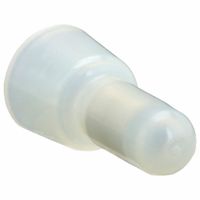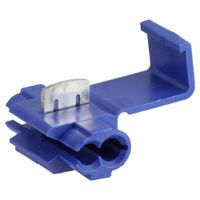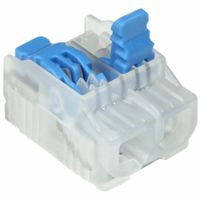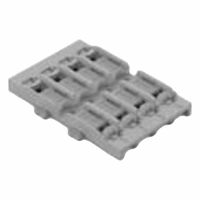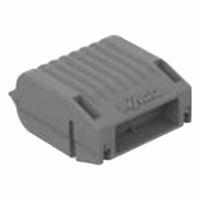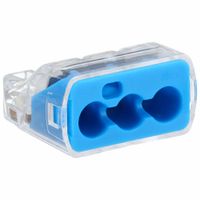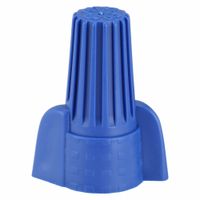Call +(254) 703 030 000 / 751 483 999 / 721 704 777
.....Read More
Frequently Asked Questions
What are the different types of wire connectors?
Wire connectors come in various types, each designed for specific applications and wire sizes. Here are some common types:
1. **Twist-On Wire Connectors**: Also known as wire nuts, these are used to connect two or more wires by twisting them together. They are available in different sizes and colors, indicating the wire capacity they can handle.
2. **Push-In Wire Connectors**: These connectors allow wires to be pushed into a slot, securing them without twisting. They are often used for quick and easy connections in residential wiring.
3. **Crimp Connectors**: Used with a crimping tool, these connectors create a secure connection by compressing a metal sleeve around the wires. They are commonly used in automotive and industrial applications.
4. **Screw-On Connectors**: These connectors use a screw mechanism to secure the wires. They are often used in terminal blocks and are suitable for high-current applications.
5. **Butt Connectors**: These are used to connect two wires end-to-end. They are often crimped and can be insulated or non-insulated.
6. **Splice Connectors**: Designed for joining two wires in a straight line, these connectors can be crimped or soldered.
7. **IDC (Insulation Displacement Connectors)**: These connectors allow wires to be connected without stripping the insulation. They are commonly used in telecommunications and networking.
8. **Lever-Nut Connectors**: These connectors use a lever mechanism to secure wires, allowing for easy disconnection and reconnection.
9. **Waterproof Connectors**: Designed for outdoor or moisture-prone environments, these connectors have seals to prevent water ingress.
10. **Terminal Blocks**: Used in control panels and junction boxes, these connectors allow multiple wires to be connected to a single point.
Each type of connector is suited for specific applications, wire sizes, and environmental conditions, ensuring safe and reliable electrical connections.
How do twist-on wire connectors work?
Twist-on wire connectors, commonly known as wire nuts, are devices used to securely join two or more electrical wires. They consist of a plastic cap with a tapered, coiled metal insert inside. The working principle involves both mechanical and electrical functions.
When wires are inserted into the connector, the metal coil inside grips the wires as the connector is twisted. This twisting action causes the wires to wrap around each other, forming a tight, secure connection. The metal insert ensures that the wires are held firmly in place, preventing them from loosening over time due to vibrations or other external forces.
The plastic cap serves as an insulator, protecting the connection from environmental factors such as moisture and dust, which could lead to corrosion or short circuits. The cap is usually color-coded to indicate the size and capacity of the connector, ensuring that the correct connector is used for the specific wire gauge and number of wires being joined.
The design of twist-on wire connectors allows for easy installation and removal, making them a popular choice for both permanent and temporary electrical connections. They are widely used in residential, commercial, and industrial wiring applications due to their reliability, ease of use, and cost-effectiveness.
In summary, twist-on wire connectors work by mechanically securing wires through a twisting action, while providing electrical insulation and protection with their plastic cap. This ensures a safe and durable connection in various electrical systems.
What is the purpose of butt splice wire connectors?
Butt splice wire connectors are used to join two or more electrical wires together, ensuring a secure and reliable connection. They serve several purposes:
1. **Electrical Continuity**: They maintain electrical continuity between wires, allowing current to flow seamlessly from one wire to another.
2. **Insulation**: Butt splices often come with insulation, which protects the connection from environmental factors such as moisture, dust, and chemicals, reducing the risk of short circuits and corrosion.
3. **Mechanical Strength**: They provide mechanical strength to the connection, preventing the wires from pulling apart under tension or vibration.
4. **Ease of Use**: Butt splice connectors are designed for easy installation, often requiring only a crimping tool. This makes them suitable for both professional electricians and DIY enthusiasts.
5. **Versatility**: They are available in various sizes and materials, accommodating different wire gauges and applications, from automotive wiring to household electrical systems.
6. **Safety**: By ensuring a secure connection, they reduce the risk of electrical fires and other hazards associated with loose or exposed wires.
7. **Cost-Effectiveness**: They offer a cost-effective solution for wire repair and extension, eliminating the need for more complex and expensive connectors.
Overall, butt splice wire connectors are essential components in electrical systems, providing a simple, efficient, and reliable method for connecting wires.
How do insulation-displacement wire connectors function?
Insulation-displacement wire connectors function by allowing electrical connections without the need to strip the insulation from the wire. These connectors have a metal blade or fork that slices through the insulation when the wire is inserted, making direct contact with the conductor inside. The process involves placing the wire into a slot or channel within the connector, which is designed to guide the wire into the correct position.
Once the wire is in place, a cap or cover is pressed down, forcing the metal blade through the insulation. This action displaces the insulation material, creating a secure electrical connection between the metal blade and the conductor. The design ensures that the connection is both electrically conductive and mechanically stable.
These connectors are often used in telecommunications, automotive, and consumer electronics due to their ease of use and reliability. They are particularly advantageous in situations where multiple connections are needed quickly, as they eliminate the need for wire stripping and soldering. The connectors are typically color-coded to indicate the wire gauge they are compatible with, ensuring proper usage.
Insulation-displacement connectors are also designed to maintain a gas-tight seal around the connection point, preventing corrosion and ensuring long-term reliability. This makes them suitable for use in environments where moisture or other corrosive elements may be present. Overall, insulation-displacement wire connectors provide a fast, efficient, and reliable method for making electrical connections in a variety of applications.
What are the advantages of push-in wire connectors?
Push-in wire connectors offer several advantages:
1. **Ease of Use**: They allow for quick and straightforward installation. Wires are simply pushed into the connector, eliminating the need for twisting or screwing, which reduces installation time and effort.
2. **Safety**: These connectors provide a secure and reliable connection, reducing the risk of loose wires that can lead to electrical failures or fires. They often include features like built-in test points for voltage checks without disconnecting the wires.
3. **Space Efficiency**: Push-in connectors are compact, making them ideal for use in tight spaces or crowded electrical boxes. Their design allows for neat and organized wiring.
4. **Reusability**: Many push-in connectors are designed to be reusable, allowing for easy disconnection and reconnection of wires without damaging the connector or the wire.
5. **Compatibility**: They are compatible with a variety of wire types and sizes, accommodating both solid and stranded wires, which adds to their versatility in different electrical applications.
6. **Reduced Fatigue**: The simple push-in mechanism reduces physical strain on installers, especially in large projects where numerous connections are required.
7. **Consistency**: They provide consistent and reliable connections, minimizing the variability that can occur with manual twisting or screwing, which can lead to inconsistent electrical performance.
8. **Cost-Effective**: While the initial cost may be higher than traditional connectors, the reduction in installation time and the potential for fewer connection failures can lead to overall cost savings.
9. **Vibration Resistance**: The secure grip of push-in connectors makes them resistant to vibrations, which is beneficial in applications where movement or vibration is a concern.
10. **Aesthetic Appeal**: The clean and organized appearance of push-in connectors can enhance the overall look of electrical installations, which is particularly important in visible or open installations.
When should closed-end crimp connectors be used?
Closed-end crimp connectors should be used in electrical applications where a secure, reliable, and insulated connection is required between two or more wires. They are ideal for situations where space is limited, and a compact connection is necessary. These connectors are particularly useful in environments where vibration or movement might otherwise cause a connection to loosen, as the crimping process ensures a tight and stable bond.
They are commonly used in automotive, marine, and industrial applications due to their durability and ease of installation. Closed-end crimp connectors are also suitable for use in household wiring projects, such as connecting wires in lighting fixtures or appliances, where a permanent and insulated connection is needed.
These connectors are beneficial when a quick and efficient installation is required, as they do not require soldering. The crimping process is straightforward and can be performed with a standard crimping tool, making them accessible for both professional electricians and DIY enthusiasts.
Additionally, closed-end crimp connectors are often used in situations where multiple wires need to be joined together, as they can accommodate several wires of varying sizes within a single connector. This makes them ideal for creating wire harnesses or connecting multiple circuits in a compact and organized manner.
Overall, closed-end crimp connectors should be used when a secure, insulated, and space-efficient connection is needed, particularly in environments subject to vibration or movement, or when multiple wires need to be joined quickly and reliably.
How do protective gelboxes for wire connectors prevent moisture damage?
Protective gelboxes for wire connectors prevent moisture damage by creating a sealed environment around the connection. These gelboxes are typically filled with a non-conductive, hydrophobic gel that envelops the wire connectors, providing a barrier against moisture, dust, and other environmental contaminants. The gel is often silicone-based, which is resistant to water and can withstand a wide range of temperatures, ensuring long-term protection.
When the gelbox is closed, the gel conforms to the shape of the connectors and wires, filling any gaps and ensuring that no moisture can penetrate. This is crucial in preventing corrosion and oxidation of the metal components, which can lead to electrical failures. The gel also acts as an insulator, maintaining the integrity of the electrical connection by preventing short circuits that could occur if moisture were to bridge the gap between conductive parts.
Additionally, the gelbox itself is usually made from durable, UV-resistant materials that can withstand harsh environmental conditions, such as extreme temperatures, sunlight, and physical impacts. This ensures that the protective qualities of the gel are maintained over time.
The design of the gelbox often includes a secure locking mechanism that keeps the box tightly closed, further preventing the ingress of moisture. Some gelboxes are also reusable, allowing for easy maintenance and inspection of the connections without compromising the protective seal.
Overall, protective gelboxes provide a reliable and effective solution for safeguarding wire connectors from moisture damage, ensuring the longevity and reliability of electrical systems in various applications.

